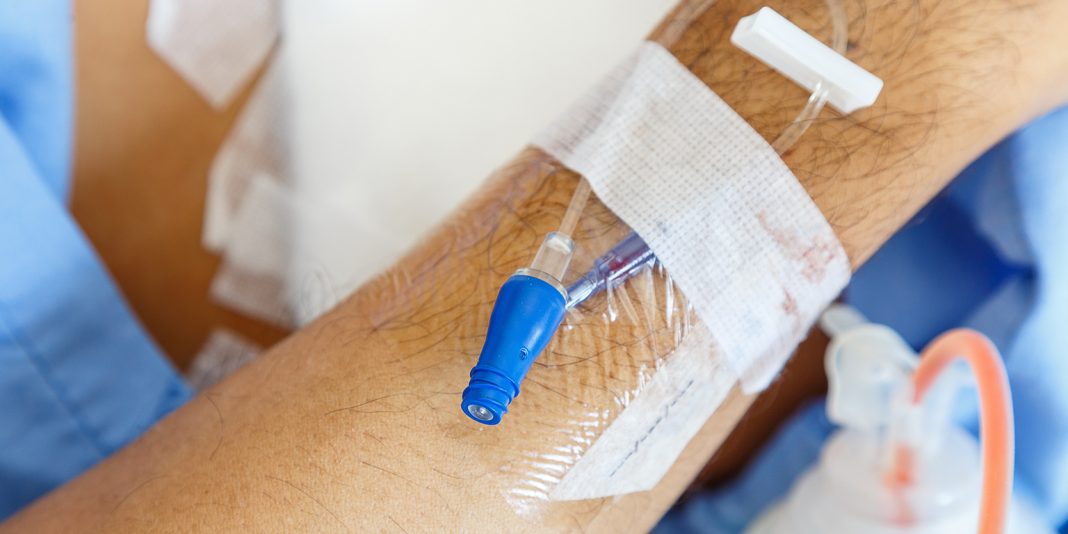Reading this article and undertaking the learning activity is equivalent to 60 minutes of professional development.
This learning activity is relevant to the Nursing Council competencies 1.1, 1.4, 2.1, 2.8, 2.9, 4.1, 4.2 and 4.3.
Learning outcomes
- Recognise the signs and symptoms of phlebitis.
- Summarise the distinguishing features of the four types of phlebitis.
- Take appropriate action to reduce the risks of phlebitis.
- Identify the risk factors and potential causes for IV cannula complications.
- Reflect on improvements that can be made to nursing practice to reduce IV complications.
Introduction
“Sam” (64) was admitted for elective surgery on his shoulder. He had had a few PIVCs during his admission. Medication from one of these cannulae (in his forearm), had infiltrated the surrounding tissue and the tissue then became necrotic. He required grafts and further surgery. This became infected. The infection went to his shoulder and he required further washouts of his shoulder1.
Insertion of a PIVC is one of the most common invasive clinical procedures performed in hospitals globally2 yet nurses are still not observing, assessing nor documenting the state of these regularly enough to reduce the risk of complications to the patient. PIVCs provide direct access into the venous system. Nurses must ensure that their knowledge and skills are up to date and based on current evidence-based practice to reduce the risk of patients with PIVCs preventing complications3.
Phlebitis
Phlebitis is one of the main complications from PIVC, with research indicating that the incidence can vary widely from less than 3 per cent up to more than 65 per cent depending on the clinical setting. This broad range suggests poor identification of phlebitis or poor reporting protocols4.
Phlebitis is defined as inflammation of the tunica intima or inner layer (see Fig. 1) of the vein, characterised by pain, redness and swelling5. The area may feel warm with a cord-like appearance of the vein and the patient may feel pain or discomfort when medication is administered.
There are four main types of phlebitis.
Chemical phlebitis is caused by fluid or medication being infused through the cannula. Key factors such as pH and osmolarity (the concentration of a solution) are known to have an effect on the incidence of phlebitis6. Blood has a pH of 7.35-7.45. Medications outside this range have the potential to damage the tunica intima (Fig. 1), the delicate inner layer of the vein (see Fig. 1), increasing the risk of patients developing phlebitis. This increases the risk of further injury to the vein, such as sclerosis, infiltration or thrombosis7.
Mechanical phlebitis happens when there is movement of the PIVC within the vein causing inflammation. This can be due to unskilled insertion or with placement of the cannula near a joint or venous valve, poorly secured cannulae, and manipulation of the cannula during administration of medication or fluid8. Having an insecure PIVC increases the risk of mechanical and infective phlebitis, with movement of the cannula causing migration of bacteria into the vein9.
Infective phlebitis is caused by bacteria entering the vein. Inflammation of the vein may begin as a non-infectious process caused by manipulation of the cannula or irritation from an infusion. Both chemical and mechanical phlebitis can produce inflammatory debris, which may serve as a culture medium for micro-organisms to multiply10. Once bacteria come into contact with the PIVC, they secrete a glue-like substance that causes the bacteria to stick to the plastic. This slimy protective substance is called biofilm. Antibiotics and white blood cells can’t penetrate this layer to kill the bacteria. Flushing and infusions can cause the biofilm to break off and travel into the patient’s bloodstream, with the associated risk of bacteraemia11.
Post-infusion phlebitis is an inflammatory response occurring after a PIVC has been removed. While most low-grade phlebitis will resolve when the cannula is removed, phlebitis may occur up to 48 hours later, with some evidence of occurrence up to 96 hours later8.

The Infusion Therapy Standards of Practice12 published in 2016 by the Infusion Nurses Society (INS), highly recommends the use of a phlebitis scale that is valid, reliable and clinically feasible; for example, the Jackson VIP Scale (Fig. 2). Intravenous Nursing New Zealand13, supports the use of the Infusion Therapy Standards of Practice to promote a consistent approach to catheter management when monitoring phlebitis. Interestingly, a systematic literature review published in 201414 identified more than 70 different phlebitis assessment scales in use worldwide. Nurses still need to be aware of the treatment required for the different types of phlebitis.

Management of phlebitis
Nurses should determine the possible aetiology of the phlebitis as noted below; apply a warm compress; elevate the limb; provide pain relief as needed; consider other pharmacologic interventions, such as anti-inflammatory agents; and use a visual scale, like the Jackson VIP Scale (Fig. 2), to consider whether removal (resiting) of the cannula is necessary10, 11. For example, if two of the following three are evident: pain near the IV site, erythema or swelling, no matter what the aetiology of the phlebitis, the PIVC must be removed and resited.
Chemical phlebitis: evaluate the infusion therapy and need for different IV access (e.g. central venous access device), different medication, or a slower rate of infusion; determine if removal of the PIVC is needed. Provide interventions as above10, 11.
Mechanical phlebitis: stabilise the IV cannula, apply heat, elevate the limb, and monitor closely. If signs and symptoms persist after 48 hours, consider removing PIVC as per Jackson VIP Scale (Fig. 2)10, 11.
Infective phlebitis: if suspected, (pain, erythema, swelling), remove the PIVC. Follow local policy regarding microbiology culture to identify the organism and incident reporting. Medical assessment will be required for the initiation of any antibiotic treatment. Monitor for signs of systemic infection10, 11.
Post-infusion phlebitis: if this appears to be a bacterial source, ensure that medical review is initiated, monitor for signs of systemic infection; if nonbacterial, apply warm compress, elevate limb, provide analgesics as needed, and consider other pharmacologic interventions. such as anti-inflammatory agents or corticosteroids as necessary10, 11.
Reducing the risks of phlebitis
Having a skilled practitioner or IV team inserting IV cannulae is proven to reduce many complications of PIVC15. IV teams are not always practical for all settings, but having skilled, trained IV practitioners who regularly update their skills and knowledge is a necessity for improving clinical quality and reducing risk. It has been demonstrated that skilled cannulators have a significantly higher first-time insertion rate, which is associated with a lower incidence of phlebitis and failure16.
Chemical phlebitis
- patients at risk may need to be referred for a central venous access device, such as a peripherally inserted central catheter (PICC) depending on the pH and tonicity of the medications to be administered7.
Mechanical phlebitis
- Prevent movement by carefully securing the cannula with a sterile, occlusive, transparent semipermeable polyurethane dressing9.
- Ensure the cannula hub is not directly accessed close to the insertion site9.
- Keep dressing dry and redress if the dressing loses its integrity.
- Select the smallest practical cannula for the largest possible vein.
- Avoid placing PIVCs near to joints i.e.
- ante-cubital fossa, to reduce irritation of the vessel wall by the tip of the cannula during movement6.
Infective phlebitis
As above (mechanical phlebitis), plus:
- Strict hand hygiene.
- Clipping excess hair from the preferred insertion site.
- Ensure strict aseptic non-touch technique during insertion of the cannula.
- Perform skin antisepsis with >0.5 per cent Chlorhexidine/70 per cent alcohol12, cleansing the skin with friction for 30 seconds and allow the solution to dry naturally. If a Chlorhexidine/alcohol solution is contraindicated, consider using povidone-iodine or 70 per cent alcohol wipes.
- No repalpating of the preferred site after cleansing.
- Use appropriate sterile IV dressing.
- ‘Scrub the hub’ of the needleless connector every time the cannula is accessed with single use disinfecting agent e.g. 70 per cent alcohol wipes or >0.5 per cent Chlorhexidine/70 per cent alcohol wipe, for at least 15 seconds12.
- Check the integrity of the PIVC dressing.
- Carefully remove the dressing that has lost its integrity and replace with new sterile dressing, taking care not to manipulate the sited cannula.
- Only use flush solutions from a single use system. Minimum of 10mL pre- and post-IV medication or according to local medication policy11.
Post-infusion phlebitis
A recent Australian study17 noted that the main predictor of post-infusion phlebitis was cannulae inserted under emergency situations, reinforcing the following recommendations:
- Replace all PIVC inserted under emergency conditions as soon as feasibly possible, i.e. within 24 to 48 hours12.
- Observe the insertion site for at least 48 hours after removal of the cannula.
- Educate the patient or family on discharge about signs and symptoms of phlebitis17.
Reducing the risk of other PIVC complications
Nurses also need to be cognisant of other complications leading to PIVC failure.
A quarter of PIVCs fail through accidental dislodgement or occlusion. Infiltration and extravasation (see Definitions box), haematoma formation or thrombophlebitis and septic thrombophlebitis may then occur18. It has been suggested that the use of visualisation devices (infrared or ultrasound) can increase the success of first-attempt insertion and decrease trauma to the patient19.
Good PIVC management
Early identification and intervention are critical to prevent serious adverse events, such as extensive tissue injury or nerve injury leading to compartment syndrome requiring surgical intervention20.
If a patient reports any burning or stinging at or around the insertion site or anywhere along the venous pathway:
- stop infusion immediately
- disconnect the IV tubing from the PIVC
- attempt aspiration of the residual medication from the cannula
- remove the cannula
- notify the medical team or senior nurse as further intervention may be required depending on the factors related to the injury13.
Elevation of the affected limb for up to 48 hours may help with reabsorption of the infiltrate. Local thermal treatment depends on the pharmacological agent infused and expert advice should be sought as to whether heat or cold is appropriate20.
If an extravasation injury does occur, ensure that the appropriate documentation is completed using an approved extravasation scale and following local policy for reporting13.
Correct PIVC placement and observation
Key factors to a successful infusion include ensuring correct placement and stabilisation of the cannula (with the patient reporting no pain or burning), and no swelling around the insertion site. The recommended guides should be carefully adhered to during infusion of any medication or fluid to reduce the risk of tissue injury and loss of the PIVC. The cannula insertion site should also be assessed and observed at least every four hours20.
Placement of PIVCs is recommended in forearm veins as opposed to the hand, wrist or ante-cubital fossa as the forearm sites are less prone to occlusion, accidental dislodgment and phlebitis21. Nurses are well placed to advocate for their patient to have a central venous access device (CVAD) placed for the administration of vesicant medications18.
Flushing protocols and administration of IV medications
There is very little research and a high degree of practice variation in the maintenance of PIVC, including the role of flushing to prevent complications. It is highly recommended that nurses refer to the manufacturer’s guidelines and local organisational policy for the recommended preparation and speed of infusion in order to prevent vein injury21. For example: 1.2g Amoxicillin plus Clavulanic Acid (Augmentin). Administration notes: Inject slowly over three to four minutes22.
Good documentation
Documentation is essential for accountability, as well as the maintenance of a high standard of professional practice; however, it is often overlooked, especially when the workload is high21.
The use of a pre-printed care plan can be useful. An example used in one New Zealand hospital includes documentation of:
- Patient information and consent
- date and time of insertion
- name and signature of cannulator
- location, type and gauge of cannula
- indication for use.
- Ongoing care documentation should include:
- cannula checked & cannula required
- needleless access device insitu
- dressing intact & dated
- cannula flushed (flush solution)
- VIP score & indication for use
- cannula removed – including date, time and reason12,13,21.
Conclusion
Early recognition of IV complications through regular assessment and observation enables appropriate and timely intervention, minimising disruption to the patient’s treatment, improving patient outcomes, as well as reducing healthcare costs involved in extra treatment and procedural requirements and increased bed days from unnecessary complications.
The following quote reinforces the intent of this article:
“Penetration of a patient’s natural protective skin barrier with a foreign body that directly connects the outside world to the bloodstream for a prolonged period of time is not to be taken lightly. Insertion of an IV catheter is an invasive procedure that introduces multiple risks and potential morbidities, and even mortalities, and should be given the respect that it deserves.”23
View PDF of this article (and related learning activity) here >>
Recommended Resources
AVATAR is an Australian-based teaching and research group aimed at “making vascular access complications history”: http://www.avatargroup.org.au
Intravenous Nursing New Zealand (IVNNZ Inc.) is a voluntary, non-profit, professional development organisation and affiliated international member of the Infusion Nurses Society (INS) and is dedicated to Best Practice Recommendations and Standards of Practice for Infusion Therapy: http://www.ivnnz.co.nz/
Infusion Nurses Society (2016.) Infusion Therapy Standards of Practice Journal of Infusion Nursing. 39 (1S)
About the author:
Bev Hopper MHPrac (Nursing), PG Cert Advanced Nursing Practice (Orthopaedics), BHSc (Nursing), NZRN (Comp) is the Clinical Nurse Specialist (Out Patient IV Antibiotics) at Waitemata District Health Board in Auckland.
This article was peer reviewed by:
Catharine O’Hara RN MN is Clinical Nurse Specialist (Lead) Intravenous & Related Therapy at MidCentral District Health Board’s Department of Anaesthesia & ICU
Rachael Haldane, RN BN PGDip HSc is a clinical nurse specialist, infusion services for Nurse Maude, Christchurch.
REFERENCES
- Personal anecdote of Beverley Hopper.
- AHLQVIST M, BERGLUND B, NORDSTROM G, KLANG B ET AL. (2010).
A new reliable tool (PVC assess) for assessment of peripheral venous catheters. Journal of Evaluation in Clinical Practice 16 (6), 1108-15. - NURSING COUNCIL OF NEW ZEALAND (2007). Competencies for Registered Nurses. Retrieved September 2016 from www.nursingcouncil.org.nz/Publications/Standards-and-guidelines-for-nurses.
- OLIVEIRA A & PARREIRA P (2010). Nursing interventions and peripheral venous catheter-related phlebitis. Systematic literature review. Referência: Scientific Journal of the Health Sciences Research Unit: Nursing 3(2), 137-47.
- DOUGHERTY L (2008). Peripheral Cannulation. Nursing Standard 22 (52), 49-56.
- HIGGINSON R (2011). Phlebitis: treatment, care and prevention. Nursing Times 107 (36), 18-21.
- KOKOTIS K (2015). Preventing chemical phlebitis. Nursing 28 (11), 41-7.
- MACKLIN D (2003).Phlebitis: A painful complication of peripheral IV catheterization that may be prevented. The American Journal of Nursing 103(2), 55-60.
- HIGGINSON R (2015). IV cannula securement: protecting the patient from infection British Journal of Nursing (8)24, S23-S28.
- MALACH T, JERASSY Z, RUDENSKY B, SCHESINGER Y ET AL. (2006). Prospective surveillance of phlebitis associated with peripheral intravenous catheters. American Journal of Infection Control 34 (5), 308-12.
- RYDER M (2005). Catheter related infections: It’s all about the bio-film. Topics in Advanced Practice Nursing eJournal 5 (3).
- INFUSION THERAPY STANDARDS OF PRACTICE (2016). Retrieved September 2016 from www.anzctr.org.au/AnzctrAttachments/369954-INSper cent20Standardspercent20ofper cent20Practice 2016.pdf
- INTRAVENOUS NURSING NEW ZEALAND. (2012). Retrieved September 2016 www.ivnnz.co.nz/files/file/7672/IVNNZ_Inc_Provisional_Infusion_Therapy_Standards_of_Practice_March_2012.pdf.
- RAY-BARRUEL G, POLIT D, MURFIELD J & RICKARD C (2014). Infusion phlebitis assessment measures: a systematic review. Journal of Evaluation in Clinical Practice 20 (2), 191-202.
- WALLIS M, MCGRAIL M, WEBSTER J, MARSH N et al (2014). Risk factors for peripheral intravenous catheter failure: a multivariate analysis of data from a randomised control trial. Infection Control and Hospital Epidemiology 35 (1), 63-8.
- DA SILVA G, PRIEBE S, DIAS F (2010). Benefits of establishing an intravenous team and the standardisation of peripheral intravenous catheters. Journal of Infusion Nursing 33 (3), 156-60.
- WEBSTER J, MCGRAIL M, MARSH N, WALLIS M ET AL (2015). Post-infusion phlebitis: incidence and risk factors. Nursing Research and Practice, 2015.
- SIMONOV M, PITTIRUTI M, RICKARD C, CHOPRA V (2015). Navigating venous access: A guide for hospitalists. Journal of Hospital Medicine 10 (7), 471-8.
- SALGUIRO-OLIVEIRA A, PARREIRA P, VEIGA P (2012). Incidence of phlebitis in patients with peripheral intravenous catheters: the influence of some risk factors. Australian Journal of Advanced Nursing 30 (2), 32-9.
- DOELLMAN D, HADAWAY L, BOWE-GEDDES L A, FRANKLIN M, ET AL. (2009). Infiltration and extravasation: Update on prevention and management. Journal of Infusion Nursing 32 (4), 203-11.
- BROOKS N (2016). Intravenous cannula site management. Nursing Standard 30, 53-62.
- New Zealand Hospital Pharmacists Association (2015). Notes on injectable drugs (7th ed.) Wellington, New Zealand.
- HELM R, KLAUSNER J, KLEMPERER J, FLINT L, ET AL (2015). Accepted but unacceptable: Peripheral IV catheter failure. Journal of Infusion Nursing 38 (3), 189-203.






















